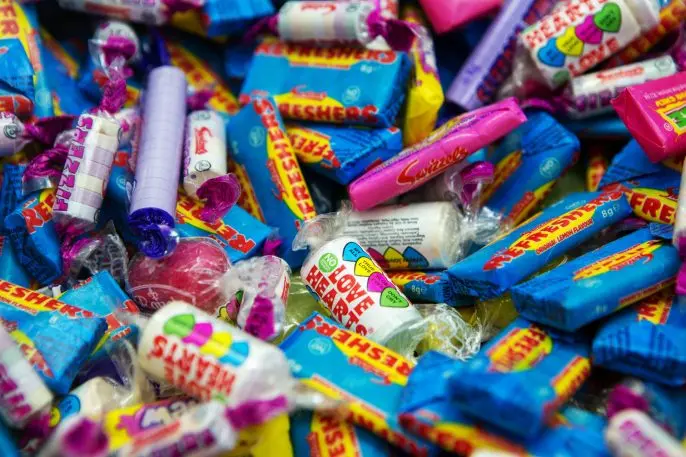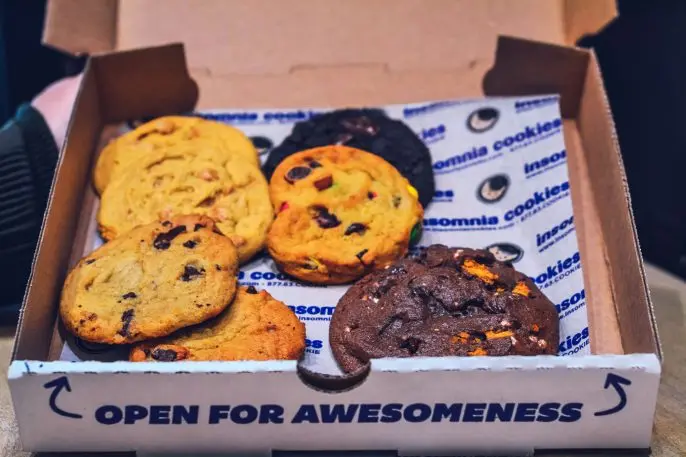Anyone who has spent time working in an office has seen how quickly a box of doughnuts gets demolished. But it’s not just genuinely tasty snacks that get gobbled up. Those three cinnamon raisin bagel quarters left over after the board meeting? Gone in seconds. Picked over Halloween candy someone’s kid didn’t want? Eaten in record time.
Reporters Lizzy Acker and Kale Williams of The Oregonian recently saw how far this trend can go, after they made a video where they tried doughnuts topped with peanut butter frosting, sriracha, and pickles made by Voodoo Doughnut in honor of the Portland Pickles baseball team. Then they offered the leftovers to their coworkers . . . who ate them.
So what is it about food at the office that entices us to betray our palettes? Why do fully grown adults—who theoretically could purchase any item of food that’s brought into their offices whenever they want—scramble to eat any snack that is introduced? We asked some experts to weigh in:
It’s free
Dr. Susan Albers-Bowling, a psychologist at the Cleveland Clinic and author of six books on mindful eating, says one of the big reasons is that it’s free. “We are motivated to try things that are free because it’s low risk,” she says. “We also feel like we’re getting a deal.”
The cost of obtaining a food could be a deterrent for unhealthy behavior, says Luke Ayers, PhD, assistant psychology professor at Widener University. “People may be less likely to spend money on a knowingly unhealthy snack,” he says. “The food being free might just remove that obstacle.”

It’s mindless
The office is also a ripe place for encouraging mindless eating, particularly in the afternoon. “We hit an afternoon slump, and a lot of us go looking for food,” says Albers-Bowling. “If it’s available, we are creatures of convenience. If it’s easy and it’s there, we go for it.”
Watching our peers eat can also trigger mindless eating. “Seeing others eating something has a contagious affect,” says Albers-Bowling.
It’s dependent on your environment
Where the eating takes place can also influence your behavior, says Ayers. You might be more open to trying new foods when you’re in a different environment, and then you connect that environment to a new habit.
“Once you eat unhealthy food in an environment, it can become routine,” he says. “The break room might become a place where people indulge or are more open to trying new foods. This kind of context-dependent behavior is very commonly seen in case studies of overeating, drug addiction, and compulsive behavioral disorders.”

It relieves stress
Another factor might be stress, says Ayers. “Eating comfort foods seems to reduce stress and anxiety in a number of people,” he says. “Interestingly, states of stress and anxiety themselves weaken our ability to maintain self-control. So, you can imagine that if someone uses the break room at work as a place to take a breather, they may be doing so while stressed. Stress makes it harder to resist temptations because it impairs our self-control functions that are mostly handled by our frontal lobes.”
The takeaway
If coworkers want to cut back on mindless eating, Albers-Bowling says there are a few things you can do. First, consider the placement of food. “If food is in a pathway or place where people hang out and congregate, it increases mindless eating,” she says. “If it’s in a location where you have to work to go to get it, that cuts down on mindless eating.”
In her office, Albers-Bowling says they moved communal food to a break room on another floor. “You had to consciously say you were going down to get it,” she says. “It cuts out the flying by and nibbling.”
Consider your motivation, says Albers-Bowling. “A good rule of thumb is if you don’t love it, don’t eat it. Do a self check-in, asking ‘Is this something I want or like?’ If you say ‘yes,’ go for it. If not, move on.”
Another way to resist something free is to stock up on your own snacks. Reach for those instead, suggests Albers-Bowling. Create a culture around what people can bring, such as having a meatless Monday, Albers-Bowling suggests. And consider consolidating birthdays, so there aren’t a lot of sweets in the office throughout the month.
People indulge in a break room because there is little reason not to, says Ayers. “The impulse or urge to eat simply wins because the barriers that we usually have in place are not present,” he says. “The food is tempting, free, and may even reduce stress, anxiety, and negative feelings. After this happens enough, some people likely form a habit of indulging in the break room, making it actually more difficult to result temptation there.”
It’s not all bad though: When a coworker brings in something unique, it can expose you to something you never would have otherwise tried, says Albers-Bowling. “Most of us are in a routine and rut around food,” she says. “Trying something new is always great.”
Recognize your brand’s excellence by applying to this year’s Brands That Matter Awards before the early-rate deadline, May 3.
